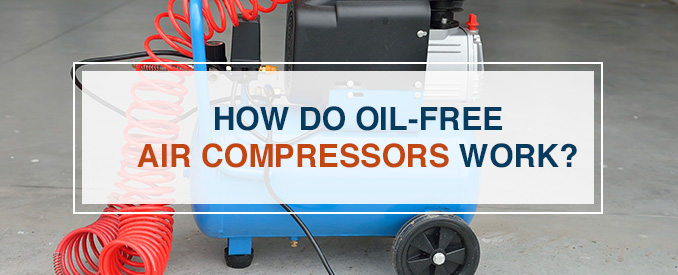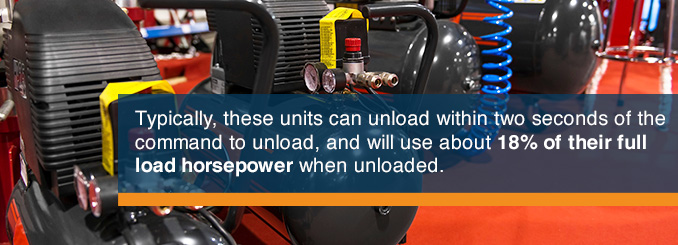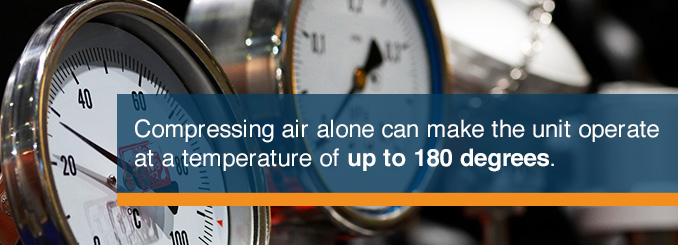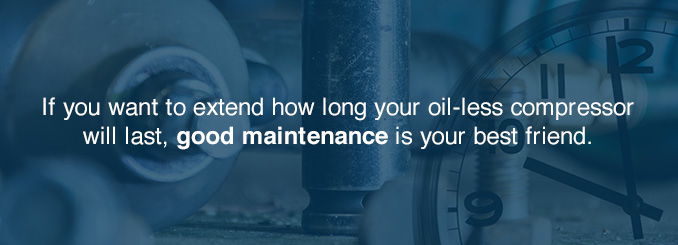
Compressed air is only as good as its purity. Oil exposures make it difficult to keep air clean, which increases costs. To address this concern, many companies use oil-free or oil-less air compressors. An oil-free air compressor is similar to an oil-injected compressor, but it doesn’t use oil for lubrication.
Today, oil-free compressors are becoming more common because they offer cost savings, have a minimal environmental impact and provide dependable performance. Learn more about how these machines work and how they can benefit your application.

How Oil-Free Air Compressors Work
Oil-free air compressors either have no mechanical contact inside the compression chamber or use alternate materials to protect the mechanism without lubrication.
Most oil-free compressors utilize other materials like water or a Teflon coating to keep the mechanism running smoothly. Because the lubrication of bearings and gears is all external to the compression chamber, proper sealing prevents any oil from contaminating the compressed air. The result is a 100% oil-free air supply. Some oil-free designs have even removed metal-to-metal contact within the compression chamber, eliminating the need for oil-based and synthetic lubrication altogether.
These purity and environmental benefits will often translate into other savings that may reduce your overall ownership costs. Here are a few things to consider if you’re contemplating switching to an oil-free model:
- There’s no need to collect or dispose of oil-ladened condensate.
- Downstream filters have reduced replacement needs, because they’re not filtering oil.
- Energy costs are minimized because there’s no need to increase force — some fluid-flooded units can see a downstream pressure drop due to filtration.
- Reduced oil costs, because there’s no need to continually refill your compressor.
- Typically, these units can unload within two seconds of the unload command and will use about 18% of their full load horsepower when unloaded.
Those savings can be very tempting. To see if you can make use of the oil-less compressors, you’ll need an understanding of how the compressors work, how they compare to other types of models and in which applications they work best.
Contact Us Learn More Find a Dealer Near You
Oil-Free Compressors and Class Zero Air
The phrases oil-free and “technically oil-free” are often used to identify the purity of compressed air. These phrases correlate with different air compressor rankings, which ultimately depend on the worldwide standards set by the International Organization for Standardization (ISO).
Air compressors are ranked based on how clean the air is after compression, from ISO Class 0-5. Class zero air is the highest air quality possible and the cleanest choice for sensitive applications.
- Oil-free compressors are guaranteed to meet ISO Class Zero certification. They provide a 100% oil-free air supply for sensitive applications. While they may have higher initial costs, oil-free compressors are safer to ensure no contamination reaches the end product.
- “Technically oil-free” compressors are ranked as ISO Class 1. These compressors are actually oil-lubricated models and are therefore at risk for contamination. They use oil-removing filters to remove most of the oil particles during compression. However, these air compressors cannot guarantee 100% oil-free air.
Oil-Injected vs. Oil-Free Compressors
The best air compressor for your facility will depend on your specific application. Oil-free compressed air is critical for many applications where oil contamination can damage production equipment or cause product spoilage and recalls. These compressors are the perfect solution to ensure your processes meet the highest air purity standards. In contrast, oil-injected compressors typically have a more durable design and can last longer than oil-free models.
When the choice narrows down to an oil-free air compressor vs. oil-injected alternatives, the following considerations may be essential to helping you find the best fit:
- Air quality: Oil-free compressors provide the best air quality possible, meaning there is no risk of contaminating your end product or process with oil.
- Noise levels: While oil-injected compressors typically have higher durability, they often produce more noise than oil-free compressors as a result.
- Energy usage: Oil-free compressors minimize leaks and energy usage, which can help cut costs on maintenance and your energy bill.
- Environmental impact: Oil-free air helps ensure better compliance with international regulations for environmental protection.
An oil-injected air compressor might be the more cost-effective option for applications where the above advantages aren’t necessary to improve efficiency or maintain safety. However, in situations where the risk of oil contamination is too high, such as food processing or medical services, oil-free air compressors are required.
Functional Steps of How Oil-Less Air Compressors Work
Understanding how oil-free air compressors work and why they last as long as they do is best illustrated by reviewing each function in a step-by-step method. Let’s walk through how an oil-less air compressor starts working and provides you with the compressed air that you need.
1. Drawing in Air
Oil-less air compressors start by bringing in outside air through their unloader valve and passing it through an inlet air filter (or filters) in order to ensure that the air is clean. The filter will limit damage to your compressor and its internal components. These filters are typically fine enough that they keep out dust, dirt and small debris.
The unloader valve opens to help the compressor pump air into its chamber, placing it in the “loaded” position. When the valve closes, the compressor enters the “unloaded” condition and begins running. When your compressor is running and actively delivering compressed air, it typically won’t be able to draw in any more air.
When you turn on your compressor and it starts to draw in air through an open unloader valve, the first destination for the air is the low-pressure compressor element.
2. First Compressor Element
You’ve probably noticed that your air compressor can create heat, and this often has to do with the low-pressure compressor element, because it’s working without any oil.
The average compressor element will operate at around 2.5 bar, and compressing air alone can make the unit operate at a temperature of up to 180 degrees. That can be more than twice as high as the temperature that oil-lubricated compressors reach, due to the lack of a flowing medium that whisks away heat.
Oil-free elements will begin compressing the air and then move it through your compressor to cool the air down so it can be used in your applications.
3. Intercooler Access
After it’s initially compressed, pistons will push the air through an intercooler, where the air can cool so it can be further compressed. Depending on your specific compressor, this step will either move it to the second compression phase or the final one.
Compressing air generates heat that limits the oxygen content of the air, thus reducing its density. Cooling the air essentially acts as a simple method for allowing denser and more oxygen-rich air to be again used by the engine, which in turn provides more fuel and improves the power output when the air compressor is working with a combustion engine.
Intercoolers are essential for two reasons. First, they cool the air down to a proper temperature to minimize the risk of any damage related to heat. Second, intercoolers allow air to be compressed at much higher PSI’s in two-stage pumps, and the cooling process means the second stage will face less wear.
Cooling air can lead to some condensation, and intercoolers will come with standard filters designed to remove moisture and water from the air. You’ll typically see this filter listed as a moisture trap.
After the air is cooled, it’s returned to your compressor for additional compressing.
4. Second, Higher-Pressure Compression
The air will move back into the main chamber of your air compressor — or the second chamber, depending on its design — and will be further compressed by a high-pressure element. The maximum pressure you’ll achieve typically ranges from 116 to 145 psig.
The air again becomes very hot due to the lack of lubrication in the surrounding elements, so it will need to be cooled once more.
5. Air Prep and Aftercooler Access
During its second phase of compression, the air will reach temperatures of around 150 degrees, requiring additional cooling before it can be used in other equipment. The aftercooler is the destination for air after its final compression stages, and this cooling allows it to be properly stored.
As air flows to the aftercooler, it will pass through a check valve designed to prevent any backflow, ensuring that air continues to compress and fill your tank. Backflow will damage your equipment and cause a major failure of the air compressor.
Many compressors — especially reciprocating compressors — are fitted with pulsation dampeners, and these are located just before the aftercooler. The dampener is designed to reduce pulsations and vibrations caused by the air compressor when it uses suction and opens discharge valves.
Pulsations can reverberate through the piping system, and these vibrations will make it difficult for your tools and machinery to measure air pressure and use it properly.
The air is finally stored or sent to your equipment for use.
6. Pressure Switches
Detection equipment in your air compressor tank will monitor the level of air you have. When it falls below a specified level, the air compressor will turn back on and start working to rebuild the pressurized air in the tank. The pressure switch is what is used to monitor and turn the compressor off and on.
- Pressure switches are typically attached to the unloader valve, though sometimes the valve is internal.
- Pressure switches are set by the factory and arrive at predefined levels.
The Oil in Oil-Free Air Compressors
Remember that air compressors contain oil that resides in the gearbox, never contacting the compressor.
The air compressor’s gearbox drives the two compressor elements with the electromotor. Gearboxes need lubrication to operate properly and can be costly to replace, so maintenance checks should review them on a regular basis. The oil in your gearbox lubricates the internal gears and bearings, as well as the bearing and timing gear located inside each compressor element.
An oil sump pumps oil from inside the gearbox. Then, an oil cooler and filter cool it before transferring it to cool the compressor and gearbox parts. The filters remove debris during this action.
Internal gearbox elements are treated with long-lasting lubrication. This puts more of a strain on the engine over time but helps oil-free models require less day-to-day air compressor maintenance.
Different Compression Cooling Elements
Understanding the general pressurization of air compressors is pretty straightforward, as it often operates the same way across oil-injected and oil-free units.
For the oil-free compressors we’re looking at, there are two main methods for cooling the compressor itself: Water and air. Air-cooled compressors, which tend to be rotary screw compressors, use outside air to cool the compressed air and the oil used in the gearbox. Air circulates and moves heat away from internal components as well as from the parts that house the oil, which helps remove heat from your compressor elements.
Water-cooled machines will have a two-part cooling system. Water moves near each element, heats up and flows away from the components, condenses and cools and then moves back toward the equipment (often via gravity). These systems will have a water-cooling circuit used for the oil, intercooler and low-pressure element. The second circuit works to cool the high-pressure element and the aftercooler.
How Long Do Oil-Less Compressors Last?
Generally, an oil-free compressor will not last as long as an oil-lubricated model because its pre-lubrication will gradually wear away and degrade over time. Oil-free compressors also tend to use a universal motor, which won’t last as long as an induction motor.
The Teflon coating often used to lubricate the internal cylinder simply wears off over time, and this wear can increase when an oil-less compressor is used in extreme temperatures or for long durations. If you’re vigilant, you can have an oil-less compressor last for years, but this requires more time and money (typically) than an oil-lubricated air compressor.
If you want to extend how long your oil-less compressor will last, good maintenance is your best friend. Air compressors have a lot of moving parts that can cause significant wear, so ensure that you’re looking inside at least once a month. Check the permanently lubricated elements, such as the cylinder’s Teflon coating and either Teflon or carbon ring seals.
Heat Troubles
Part of how oil-less air compressors work includes a significant generation of heat. The more stress they’re put under or the higher the pressure you’re going for, the more likely it is that your air compressor will grind against itself or generate enough heat to burn out and/or warp components.
Oil-free air compressors tend to have a smaller clearance than their oil-injected counterparts, which means there may be less room for them to intake and move enough air to circulate and cool properly. To avoid this, you need to run the compressor only at its manufactured specifications and ensure that you’re providing plenty of space surrounding the unit to keep its exhaust and intake lines free from heat-causing dust and dirt.
Types of Air Compressors
When you’re ready to make your selection for an air compressor, it’s important to understand the three main types of compressors. The method of compression can impact their ability to output at a higher power level, be more portable or maintain more consistent pressure.
Reciprocating
Reciprocating air compressors use positive displacement, which generates air pressure via two sides that provide either suction or discharge. Positive displacement is suitable for compressing small amounts of air at high pressures and can quickly dissipate the heat from compression.
Reciprocating compressors tend to have a lower output than others, but they can achieve relatively high pressures. Non-lubricated reciprocating compressors will typically use a Teflon piston ring instead of oil. The Teflon ring means there’s no need for lubrication for the pistons, rings and cylinders because the material reduces wear. To improve life, these units also tend to opt for aluminum pieces in place of cast iron.
Teflon rings will need to be replaced regularly, but they present little contamination risk to the compressor.
Rotary Screw
Rotary screw air compressors also use displacement and generate the air compression by running a system of interlocking screws that draw in air and then pressurize it in a small area.
Oil-free rotary screw compressors opt for non-contacting carbon ring seals to aid their cooling. These seals prevent any oil from entering the air stream inside of the air compression unit. Sectioned-off coolant is used and kept on the other side of the seal for easy cooling.
Oil-free rotary screws can see heat buildup over time since they typically lack the ability to throttle the inlet, which will see those with large demands opt for the flooded models.
Scroll Compressors
Scroll technology is an advanced air compression system that includes one mobile and one stationary spiral, which work together to bring air into the chamber for compression. Air is compressed within the spiral by decreasing the volume of the air, then directing the air to the center of the compressor to be cooled.
The biggest advantage of this technology is that there is no residual friction or wear on the system because the spirals never contact each other. In many cases, these compressors also work more smoothly, producing a different sound from other compressors. Some may require lubricant, but many common models operate with an oil-free design.
Benefits of Oil-Free Air Compressors
Oil-free compressors have many advantages for users, such as:
- Less maintenance: Oil-free compressed air has significantly fewer maintenance requirements than oil-injected compressed air. Oil-filled compressors need regular oil changes, which can be expensive. Users also have to safely dispose of expired oil, which costs even more. However, oil-free compressors don’t require manual oil changes. The most significant maintenance requirement is draining the tank after every use. This action is more cost-effective and less time-consuming than oil-injected practices.
- Lower cost: Oil-free compressors have fewer financial requirements than oil-injected ones. They usually have lower upfront costs and last for a long time, making them worthwhile investments. Oil-free compressors have minimal components, so they require less money for maintenance and replacements. Some model types are equipped with regulators that minimize energy use, decreasing fuel expenses.
- Environmental friendliness: Oil-free compressors also have a minimal environmental impact. Oil-injected units release pollutants into the atmosphere, which can harm employees and the environment. In contrast, oil-free models’ lack of oil minimizes environmental harm.
- A diminished risk of contamination: Oil contamination can lower or compromise the quality of your products, which could harm your brand’s reputation — or even worse, your customers’ health. Oil-free compressors are often required in fields like food and medicine, where oil-free, clean air is essential.
- Multiple uses: You can position oil-free compressors in various orientations based on your required task, which displays their versatility. Their low weight and small size make them easy to transport. You can also move them freely without worrying about oil leaks.
- A faster start: Oil-free compressors start more quickly, which can assist with project efficiency. Oil-injected compressors require more amps to start, taking them longer to power on. Oil has a viscous nature that makes it harder to move when cold. In contrast, oil-free compressors start fast no matter the surrounding temperature.
No matter its application, an oil-free compressor has minimal effects on the environment and lowers your operational expenses.
Oil-Free Air Compressor Applications
Oil-free air compressors can meet the needs of many industries and applications, including:
- Pharmaceutical and medical: Cleanliness is critical for pharmaceutical and medical applications. To meet compliance standards, manufacturers might have to limit or eliminate oil use entirely. Every stage of medical manufacturing must follow strict guidelines, including the use of compressed air. By using oil-free compressors, you decrease the presence of possible contaminants in products.
- Food: The Food Safety Modernization Act (FMSA) emphasizes how vital cleanliness is during food production. Oil-free compressors help food manufacturers avoid oil contaminants, letting them create a more sterile production environment.
- Electronics: Oil-free compressors deliver pure and dry air for various electronic devices, such as printed circuit boards. These products contain intricate details that need preservation.
- Textiles: Clean compressed air reduces production losses and fabric stains. The textile industry must meet certain compliance standards for safe production, such as air purity standards. Oil-free compressors allow for clean production.
- Natural gas: The natural gas industry gathers, stores and transports natural gas. Heavy-duty applications like fume elimination, gas transfers and vapor recovery need compressed air. Oil-free compressors provide pure air without additional oil or contaminants.
- Dry cleaning: Oil-free compressed air is essential for activities like pressing garments and processing solvents. The compressed air doesn’t damage or add contaminants to clothing.
- Energy exploration: Energy exploration teams identify oil and use various tools to extract it. Oil-free compressors have minimal maintenance and upkeep requirements, making them dependable choices for fieldwork.
- Plastics: Plastic manufacturing requires steady supplies of air. Oil-free compressors are dependable options because of their minimal components and maintenance requirements. They provide consistent and clean air for plastic production.
- Woodworking: Various woodworking businesses, such as furniture manufacturers, benefit from oil-free compressors’ cost-effective and dependable nature.
- Low-pressure environments: Oil-free compressors are ideal for low-pressure applications, like heating and cooling and aeration.
- Plumbing: Plumbing professionals use oil-free compressors to test the water pressure in piping systems. The clean and oil-free units let technicians evaluate water quality without the interference of contaminants.
- Painting: Painters can use compressed air for spray painting or to refine their artwork. Oil-free compressors let painters complete their art without the presence of oil.
- Amusement parks: Roller coasters require clean compressed air, making oil-free compressors a perfect choice. Air systems can facilitate ride movement, help cars arrive at a stop, add to the immersive experience and complete many other tasks.
- Aerospace: From launching rockets to controlling contamination, clean compressed air has many applications in the aerospace industry.
Oil-free compressed air also contributes to many other industries not named here.
Choosing Oil-Free With Quincy Compressor
Oil-free air compressors are a more thoughtful choice and require careful consideration for your operations. The fundamentals of how oil-less air compressors do their work means you could be looking at lower costs, a better footprint and cleaner air.
If you’re in an industry that demands air purity at 100% clean levels, then a compressor that doesn’t rely on internal oil is a top bet. By not using oil, you’ll also be able to lower your carbon footprint, and these smaller units also tend to require less energy because they have more options for speed regulations.
Quincy Compressor offers a suite of oil-free air compressors and can make recommendations specific to industries such as electronics, pharmaceuticals, textiles and food and beverage applications. We stick to the ISO 8573-1: 2010 standard to ensure that your air purity needs are always met.
When you’re ready, reach out to your local authorized Quincy Compressor distributor to get all of the information you need about specialty models, including the QOF oil-free scroll compressor, and to receive a no-obligation price quote for your application.
Contact Us Learn More Find a Dealer Near You
Last Updated June 28, 2023 at 12:15 pm
Table of Contents
- How Oil-Free Air Compressors Work
- Oil-Free Compressors and Class Zero Air
- Oil-Free vs. Oil-Injected
- Functional Steps of How Oil-Less Air Compressors Work
- The Oil in Oil-Free Air Compressors
- How Long Do Oil-Less Compressors Last?
- Types of Air Compressors
- Benefits of Oil-Free Air Compressors
- Oil-Free Air Compressor Applications




